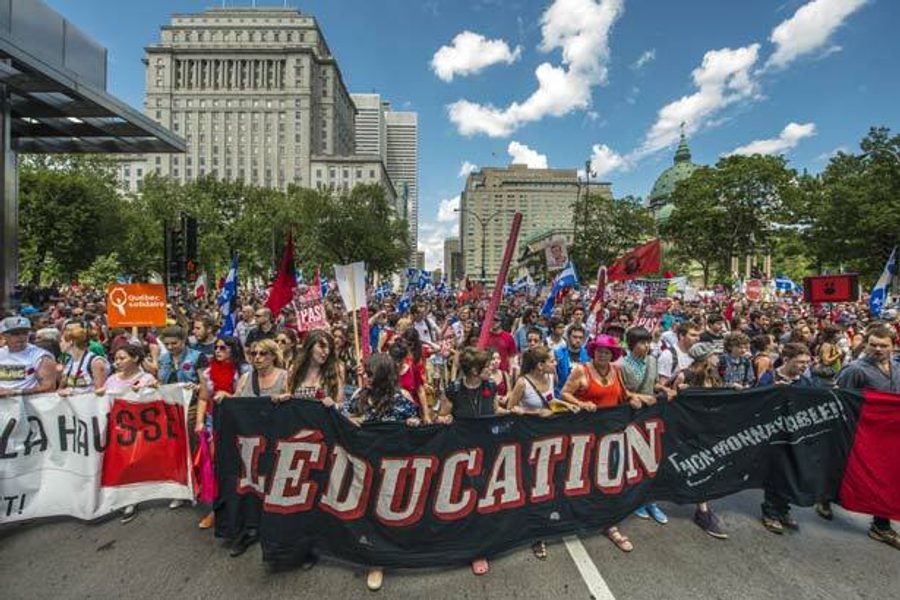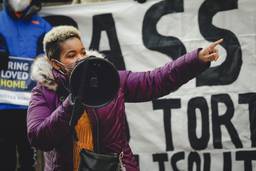
After successfully beating back a 75% tuition hike, Quebec’s students are preparing to head back to the streets this weekend. This time, they’ll be marching with a loftier demand: free education for all.
A march planned for Saturday by CLASSE, the strike-time coalition of the most combative student unions, will be the first major street demonstration to take place since the provincial elections earlier this month. Student mobilization is widely credited with the defeat of the Liberal party and the resignation of Jean Charest after nine years as the province’s premier. Charest’s administration had pushed the tuition hike and painted the students as “troublemakers” who lacked support from the “silent majority,” and some analysts had predicted that the strike would help him win reelection. But the opposition Parti Québécois [PQ] campaigned on promises to halt the hike and repeal the draconian anti-protest Law 12, and since August many students have returned to the universities and focused their efforts on ousting Charest.
On Thursday, the new government cancelled the hike in its first cabinet meeting. Jérémie Bédard-Wien, financial secretary for CLASSE, asserts that this represents an important win for students, but emphasizes that it was made possible only by sustained pressure from outside movements.
“We must reclaim this victory as a victory of our social movement rather than an outcome of the electoral process,” he tells In These Times. “Had there not been a general strike, the PQ would never have taken this position on the tuition hike. This is a party that has proposed tuititon increases in the past and does not listen to the concerns of students, but it did respond to intense political pressure.”
In a moment of electoral angst for many U.S.-based movements, the chronicles of our northern neighbors have been offered by some as a lesson on everything that Occupy is not. In addition to an explicit strategy on how to influence electoral politics, the student strike was built around a clear and achievable demand. Though CLASSE has consistently advanced the position that education should be entirely state-funded and free of corporate influence, the student movement agreed to coalesce around the minimal goal of a tuition freeze.
Making demands and winning partial concessions from the state, as Samuel Farber noted recently, does not necessarily co-opt movements. In fact, it can further embolden them by delivering the kind of victories that have been difficult to discern within a big tent movement like Occupy.
There’s a saying in post-Mubarak Egypt that addresses this (heretofore inevitable) problem of unfinished revolution: “The people know the way back to the square.” Whether they will return again in the same numbers, however, is another question. Will electoral victory sap the strength of a student uprising that was on the brink of broadening into a “social strike?”
There are a number of reasons why such a wide-ranging rebellion never materialized, despite calls by CLASSE and other groups. Though trade unions provided material support to the striking students, they ultimately failed to endorse the concept of a 24-hour social strike. The nightly casserole marches began diminishing during the summer, and rifts developed in the assemblies between students who advocated entering the electoral ring and those who pushed to continue the strike until their demands were met independently. Léo Bureau-Blouin, a former leader of a student federation, was brought in as a PQ candidate, to the dismay of many in the movement. In August, the strike wound down as students at a majority of junior colleges voted to return to the universities, faced with the early return to classes mandated by Law 12 and the threat of fees levied on student associations who continued to strike.
This was not the result that many in CLASSE were hoping for. But Bédard-Wien also stresses that a number of student unions voted to continue their strike for one day each month, and says that the strike had a “transformative effect” on student unions that will enable the movement to continue building a broader campaign. “Demands that are possible to attain are very important to mobilize people,” he says. “And never have we had so many conversations about free education, about solidarity with other social movements, as this spring.”
In addition to continuing with monthly street demonstrations, students are mobilizing ahead of a summit on post-secondary education that the new government has pledged to hold within the first 100 days of its mandate. Bédard-Wien notes that the PQ may yet propose indexing tuition to the cost of living, which he calls “a tuition hike in disguise.” Quebec’s students are also hoping to export their lessons to the rest of the country, which pays much higher tuition.
“We’ve managed to demonstrate that if we pay the lowest tuition in the country, it is because we have fought,” he asserts. “ … But now that the tuition hike is behind us, we are free to concentrate on the next big battle: for free education and universities that serve the needs of society rather than the private sector.”

I hope you found this article important. Before you leave, I want to ask you to consider supporting our work with a donation. In These Times needs readers like you to help sustain our mission. We don’t depend on—or want—corporate advertising or deep-pocketed billionaires to fund our journalism. We’re supported by you, the reader, so we can focus on covering the issues that matter most to the progressive movement without fear or compromise.
Our work isn’t hidden behind a paywall because of people like you who support our journalism. We want to keep it that way. If you value the work we do and the movements we cover, please consider donating to In These Times.
Rebecca Burns is an In These Times contributing editor and award-winning investigative reporter. Her work has appeared in Bloomberg, the Chicago Reader, ProPublica, The Intercept, and USA Today. Follow her on Twitter @rejburns.




